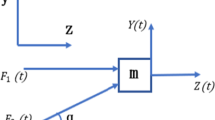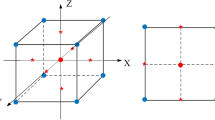Abstract
Ultrasonic elliptical vibration cutting (UEVC) is a superior machining method for difficult-to-cut materials. The shape of the elliptical tool trajectory crucially affects the integrity of the machined surface. However, the existing designs of UEVC tool typically suffer from difficult motion decoupling, resulting in the low controllability of elliptical trajectory. This study presents a new optimization design method of UEVC tool with dual longitudinal generators to create well-decoupled elliptical trajectory. A theoretical model which establishes the effects of key design variables on the tool resonant characteristics was adopted to optimize the configuration angle (the included angle of two longitudinal generators) as 90°. The structural parameters of the connection blocks of the two generators were also optimized to achieve resonance matching in both the normal (depth-of-cut) and tangential (cutting) directions. The optimized tool has a stable resonant frequency of 18 kHz, a working space of 5.1 μm × 5.3 μm, and a small trajectory error of less than 0.75 μm. The vibration measurement results showed that the optimized design can enable the high controllability of tool trajectory. Grooving experiments were conducted to verify the improved cutting performance of the designed tool due to the excellent control of tool trajectory.
























Similar content being viewed by others
Data availability
The data used or analyzed in the study are available from the corresponding author on reasonable request.
Code availability
There is no program or software related code setting in this study.
References
Ma C, Hu D (2003) Ultrasonic elliptical vibration cutting. Chin J Mech Eng 39(12):67–70
Kim G, Loh B (2007) An ultrasonic elliptical vibration cutting tool for micro V-groove machining: kinematical analysis and micro V-groove machining characteristics. J Mater Process Technol 190(1–3):181–188
Kim D, Cha K, Sung I, Bryan J (2002) Design of surface micro-structures for friction control in micro-systems applications. CIRP Ann-Manuf Technol 51(1):495–498
Brandner J, Anurjew E, Bohn L, Hansjosten E, Henning T, Schygulla U, Wenka A, Schubert K (2006) Concepts and realization of microstructure heat exchangers for enhanced heat transfer. Exp Thermal Fluid Sci 30(8):801–809
Fang F, Zhang X, Weckenmann A, Zhang G, Evans C (2013) Manufacturing and measurement of freeform optics. CIRP Ann-Manuf Technol 62(2):823–846
Wang J, Liao W, Guo P (2019) Modulated ultrasonic elliptical vibration cutting for ductile-regime texturing of brittle materials with 2-D combined resonant and non-resonant vibrations. Int J Mech Sci 170(15):105347
Kim G, Loh B (2013) Cutting force variation with respect to tilt angle of trajectory in elliptical vibration V-grooving. Int J Precis Eng Manuf 14(10):1861–1864
Huo B, Zhao B, Yin L, Guo X, Wang X (2021) Effect of double-excitation ultrasonic elliptical vibration turning trajectory on surface morphology. Int J Adv Manuf Technol 113:1401–1414
Zhang J, Suzuki N, Shamoto E (2013) Investigation on machining performance of amplitude control sculpturing method in elliptical vibration cutting. Procedia Cirp 8(Complete):328–333
Brehl D, Dow T (2008) Review of vibration assisted machining. Precis Eng 32(3):153–172
Shamoto E, Suzuki N, Naoi Y (2002) Development of ultrasonic elliptical vibration controller for elliptical vibration cutting. CIRP Ann-Manuf Technol 51:327–330
Yin Z, Dai C, Cao Z, Li W, Chen Z, Li C (2020) Modal analysis and moving performance of a single-mode linear ultrasonic motor. Ultrasonics 108:106216
Zhang S, Guo Y, Chen Z, Li G, Guo Q, Wu Y, Zeng J (2021) Proposal for a novel elliptical ultrasonic aspirator and its fundamental performance in cartilage removal. Ultrasonics 109:106259
Li X, Zhang D (2006) Ultrasonic elliptical vibration transducer driven by single actuator and its application in precision cutting. J Mater Process Technol 180(1–3):91–95
Lin J, Han J, Lu M, Zhou J, Gu Y, Jing X, Feng D (2017) Design and performance testing of a novel three-dimensional elliptical vibration turning device. Micromachines 8(10):305
Kurniawan R, JoKo T, Kumaran S, Ahmed F (2021) 3-DOF ultrasonic elliptical vibration tool holder based on coupled resonance modes for manufacturing micro-groove. Precis Eng 67:212–231
Shamoto E, Moriwaki T (1999) Ultaprecision diamond cutting of hardened steel by applying elliptical vibration cutting. CIRP Ann-Manuf Technol 48(1):441–444
Zhou M, Hu L (2015) Development of an innovative tool for ultrasonic elliptical vibration cutting. Ultrasonics 60:76–81
Amini S, Khosrojerdi M, Nosouhi R (2017) Elliptical ultrasonic–assisted turning tool with longitudinal and bending vibration modes. Proc Institution Mech Eng Part B J Eng Manuf 231(8):1389–1395
Guo P, Ehmann K (2013) Development of a tertiary motion generator for elliptical vibration texturing. Precis Eng 37(2):364–371
Guo P, Ehmann K (2013) An analysis of the surface generation mechanics of the elliptical vibration texturing process. Int J Mach Tools Manuf 64(1):85–95
Zhang C, Guo P, Ehmann K, Li Y (2016) Effects of ultrasonic vibrations in micro-groove turning. Ultrasonics 67:30–40
Yang Y, Pan Y, Guo P (2017) Structural coloration of metallic surfaces with micro/nano-structures induced by elliptical vibration texturing. Appl Surf Sci 402(APR.30):400–409
Guo P, Lu Y, Ehmann K, Cao J (2014) Generation of hierarchical micro-structures for anisotropic wetting by elliptical vibration cutting. CIRP Ann-Manuf Technol 63(1):553–556
Shamoto E, Suzuki N, Tsuchiya E, Hori Y, Inagaki H, Yoshino K (2005) Development of 3 DOF ultrasonic vibration tool for elliptical vibration cutting of sculptured surfaces. CIRP Ann-Manuf Technol 54(1):321–324
Huang W, Yu D, Zhang M, Ye F, Yao J (2017) Analytical design method of a tool for ultrasonic elliptical vibration cutting. J Acoust Soc Am 141(2):1238
Zhang C, Song Y, Ehmann K (2019) Design and kinematic analysis of a novel decoupled 3D ultrasonic elliptical vibration assisted cutting mechanism. Ultrasonics 95:79–94
Kurniawan R, JoKo T, Ping L, Kumaran S, Kiswanto G, Guo P, Ehmann K (2017) Development of a two-frequency, elliptical-vibration texturing tool for surface texturing. J Mech Sci Technol 31(7):3465–3473
Moriwaki T (2010) Development of 2-DOF ultrasonic vibration cutting device for ultra-precision elliptical vibration cutting. Key Eng Mater 447–448:164–168
Lin J, Han J, Lu M, Yu B, Gu Y (2017) Design, analysis and testing of a new piezoelectric tool actuator for elliptical vibration turning. Smart Mater Struct 26(8):085008
Tan R, Zhao X, Zou X, Sun T (2018) A novel ultrasonic elliptical vibration cutting tool based on a sandwiched and symmetrical structure. Int J Adv Manuf Technol 97(1):1397–1406
Yang Y, Gao S, Chen K, Pan Y, Guo P (2017) Vibration analysis and development of an ultrasonic elliptical vibration tool based on a portal frame structure. Precis Eng 50:421–432
Lin S, Kong X, Wang C, Yun Z, Liang Y (2018) A novel three-dimensional elliptical vibration cutting tool based on the freedom and constraint topologies theory. Proc Institution Mech Eng Part B J Eng Manuf 233(3):1–11
Richardson A, Walsh K, Abdullah M (2013) Closed-form equations for coupling linear structures using stiffness and damping elements. Struct Control Health Monit 20(3):259–281
Shamoto E, Hashimoto Y, Shinagawa M, Sencer B (2014) Analytical prediction of contact stiffness and friction damping in bolted connection. CIRP Ann-Manuf Technol 63(1):353–356
Suzuki N, Yokoi H, Shamoto E (2008) Improvement of load characteristics of 3 DOF ultrasonic elliptical vibration tool. Proc JSPE Semestrial Meeting 2008A:B63
Deng Y, Chen T, Liu S, Ye M (2018) Design and optimization of a double-excitation ultrasonic elliptical vibration grinding device. Piezoelectrics & Acoustooptics 42(2):182–186
Benaroya H (2004) Mechanical vibration: analysis, uncertainties, and control. CRC Press/Taylor & Francis
Moriwaki T, Shamoto E (1999) Ultrasonic elliptical vibration cutting. CIRP Ann-Manuf Technol 44(1):31–34
Zhang X, Kumar A, Rahman M, Liu K (2013) Modeling of the effect of tool edge radius on surface generation in elliptical vibration cutting. Int J Adv Manuf Technol 65(1–4):35–42
Funding
The authors gratefully acknowledge the financial support for this research provided by the Shenzhen Basic Research Discipline Layout Project of China (Subject Layout) (Grant No. JCYJ20160428181916222) and National Natural Science Foundation of China (Grant No. 51875311 and 52105458).
Author information
Authors and Affiliations
Contributions
Authors carry equal contributions.
Corresponding author
Ethics declarations
Ethics approval
Authors promise that this manuscript is original, and it has not been published in whole or in part, nor is it being considered for publication or submission elsewhere.
Consent to participate
We make sure the author group, the corresponding author, and the order of authors are all correct at submission.
Consent for publication
The authors have reviewed the present version of the manuscript and approved it for the final publication.
Conflict of interest
The authors declare no competing interests.
Additional information
Publisher's Note
Springer Nature remains neutral with regard to jurisdictional claims in published maps and institutional affiliations.
Rights and permissions
About this article
Cite this article
Yang, J., Feng, P., Zhang, J. et al. Design optimization of ultrasonic vibration cutting tool to generate well-decoupled elliptical trajectory. Int J Adv Manuf Technol 119, 7199–7214 (2022). https://doi.org/10.1007/s00170-022-08745-9
Received:
Accepted:
Published:
Issue Date:
DOI: https://doi.org/10.1007/s00170-022-08745-9




